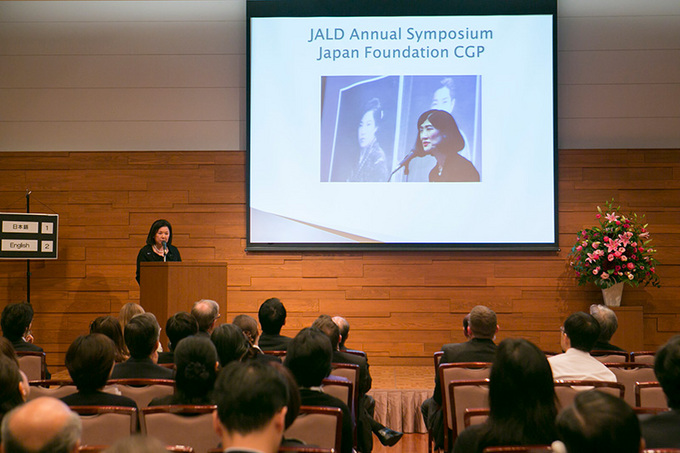Sustained People-to-People Relationships: A Foundation for U.S.-Japan Relations
Irene Hirano Inouye
President, U.S.-Japan Council
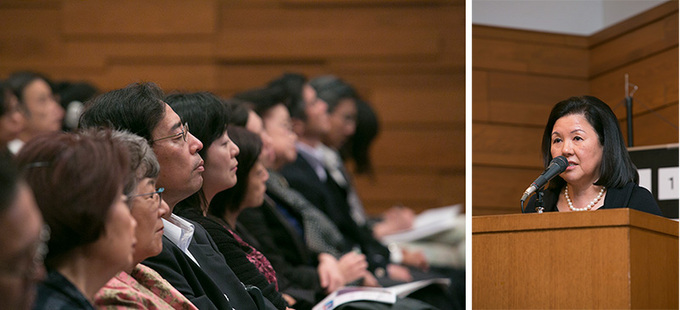
The Japan Foundation Awards (2012) Commemorative Lecture "Sustained People-to-People Relationships: A Foundation for U.S.-Japan Relations" by Irene Hirano Inouye took place at the International House of Japan (Tokyo) on October 11, 2012.
Endeavors of Japanese Americans
The Japanese American National Museum founded in 1992 was initially housed in a Buddhist temple building constructed in 1925 by Issei (first generation Japanese Americans) who had immigrated to the United States from Japan and settled in the Los Angeles area. In 1994, two years after its founding, Their Imperial Majesties the Emperor and Empress of Japan visited the National Museum and, after seeing the "Issei Pioneers: Hawaii and the Mainland, 1885-1924" exhibition held at the time, highly praised the Issei for their achievements over the years. And in 1999, a new museum building was constructed adjacent to the original building. The National Center for the Preservation of Democracy, established in 2007, regularly holds exhibitions about ethnic communities, including Japanese Americans; current displays include an exploration of the lives and military experiences during World War II of seven Americans from African, Jewish, Filipino, Japanese and other ethnic backgrounds.
The opening of the Japanese American National Museum in 1992 drew some 65,000 supporters from the 50 states across the United States. Their enthusiasm and the support extended by 16 countries around the world were major factors in uniting the Japanese American community with its shared endeavor to open the Museum. The Museum currently has the largest collection of its kind in the world comprising more than 50,000 pieces of materials on Japanese Americans including photographs, artifacts, documents, images, and other objects. The Museum works to conserve these assets and also organizes travelling exhibitions which are held in museums around the United States, such as the Smithsonian in Washington D.C. and the Ellis Island Immigration Museum in New York City. Exhibitions have also taken place at museums in Japan and countries in South America.
It was donations from local communities and financial assistance from organizations that made it possible to establish the Museum. For the historic initial stage of construction in 1992, $13.5 million was collected, followed by $45 million for the second stage of construction, of which $10 million was provided by Japanese firms. Additional funds and money for individual programs were also donated and a total of $100 million was procured for the construction and operation of the Museum.
Restoring the broken ties with our ancestors and Japan
The Museum's first agenda was to deepen ties with Japan. We worked to reconnect the links between third- and fourth-generation Japanese Americans and their Japanese ancestry, which had been severed by World War II.
The first Japanese immigrants arrived in the U.S. in 1865 and settled along the East Coast. In 1888, contract workers were sent to plantations in Hawaii, and at the beginning of the 20th century, Japanese immigrants began to settle on the U.S. mainland. My grandparents were originally from Fukuoka in the Kyushu region and moved to Los Angeles around that time. I was told that there were many immigrants from Kyushu back then. But the U. S. government enacted the Immigration Act of 1924 to stop accepting immigrants from Japan and prohibit aliens from owning land. The law deprived Issei, who had come to the United States, started their lives with families, raised children, and formed communities while fighting hardships and anti-Japanese feelings, of their hard earned land.
When World War II began, Japanese Americans were designated as enemy aliens. More than 120,000 Japanese and Japanese Americans living along the West Coast lost their homes and were sent to internment camps. They were allowed to take only two suitcases full of their belongings, and Nisei (second generation) were forced to live in inland detention facilities surrounded by barbed wire.
In Hawaii, young Japanese Americans volunteered to join the military and several thousand Nisei enlisted, including my husband who was born in Hawaii. They fought with uncommon distinction and the Japanese American combat team became the most decorated infantry regiment in the U.S. military history. Their patriotism and allegiance strongly boosted the spirits of Japanese Americans who shared the ordeals at that difficult time.
After the War, Japanese Americans were freed from the relocation camps, but were reluctant to speak of their experiences there. They didn't tell their children, Nisei and Sansei (third generation), of the hardships and humiliation that they had borne. As a result, the children grew up not knowing the sufferings of their parents and grandparents until the 1960s when they first became aware of how Japanese Americans had been deprived of their civil rights and lived in adversity during the War. After the Civil Liberties Act of 1988 was enacted under President Ronald Reagan, a formal apology was made and compensation given to the surviving Japanese Americans.
Sansei and Yonsei (fourth generation) Japanese Americans who lost touch with their ancestry
Parents of Sansei and Yonsei had a strong desire to raise their children to have hopes and be given opportunities as Americans; as a result, however, their ties with Japan broke down. But during the 60 years after the War, the Japanese American community changed significantly. In other Asian American communities, one out of six has mixed parentage, but with the Japanese Americans the ratio rises to one out of three. Many in the community have parents of different ethnic backgrounds and this fact has transformed the mindset of many young Japanese Americans.
Now we see a new change in the minds of young Japanese Americans, which could offer a major opportunity for the community. They are beginning to show interest in learning their ethnic background and identity, and the important issue of why historically their ties with Japan came to be severed.
With this trend in the backdrop, and with the support of the Japanese Ministry of Foreign Affairs, the Japanese American Leadership Delegation (JALD) Program was started in 2000. The Japan Foundation has also been providing support since 2003. The program has encouraged young Japanese Americans to deepen their understanding of Japan, and young leaders have worked hand-in-hand to promote U.S.-Japan relations. Every year, 10 to 15 members are selected to participate, and a total of 150 young Japanese Americans have now completed the program. A network has also sprung up among program graduates who keep in touch with one another.
The JALD holds a symposium every year with financial assistance from the Japan Foundation. The 2011 symposium took place in the quake-stricken city of Sendai, and the 2012 symposium participants also visited areas affected by the disaster. For 2013, we are currently planning to hold a symposium in Fukushima, inviting key figures from the government and business community.
Founding of the U.S.-Japan Council
The U.S.-Japan Council was founded in 2009, as an organization to strengthen U.S.-Japan relations, with support from many JALD alumni, and other interested parties in Japan and the U.S.
After the Great East Japan Earthquake of March 11, 2011, the Council focused its resources on the recovery efforts. We made tireless efforts from immediately after the disaster to start an earthquake relief fund and collected around $2.6 million from all over the U.S.; donations were made by prominent foundations and individuals, mostly from Japanese Americans. The Council's executive board decided not only to support nonprofit and nongovernmental organizations but also to build long-term stable relationships with communities so the Council would maintain a connection with civil society in Japan. Organizations supported by the earthquake relief fund include the Japan Platform, Peace Boat, and other groups which continue to be important partners of the U.S.-Japan Council. Other than the relief money, many other programs were launched, such as the "Genki Mail" project through which American journalists delivered messages of hope from children in the United States to the people living in the devastated areas, and a website to assist the recovery by carrying inspirational stories from the region. Just three months after the disaster, the executive board members of the U.S.-Japan Council visited the Tohoku region and began many collaborative activities with the local nonprofit and nongovernmental organizations.
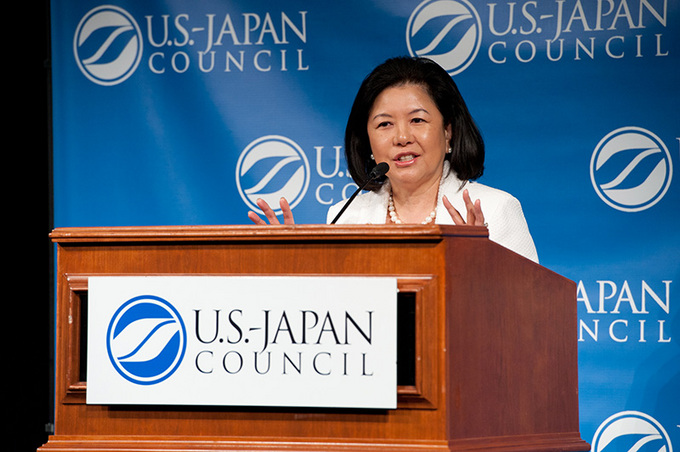
At the 2011 U.S.-Japan Council Annual Conference

(Left) Secretary Clinton delivered keynote address at the 2011 U.S.-Japan Council Annual Conference
(Right) U.S. Ambassador to Japan John Roos and then Japanese Ambassador to the United States Ichiro Fujisaki announced the launch of the TOMODACHI Initiative Educational and Exchange Programs, aiming to promote exchanges between future American and Japanese leaders for the long-term support of Japan's recovery.
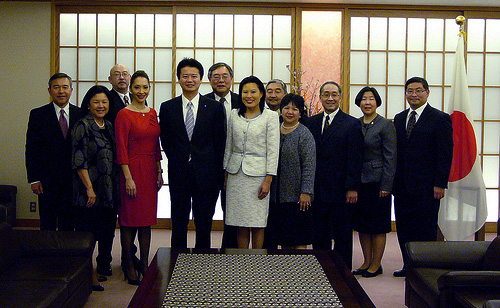
Japanese American leaders visit Japanese Minister of Foreign Affairs Koichiro Gemba in March, 2012. They reported on the discussions at the JALD Symposium "Empowering Civil Society for the Future of Japan" held in Sendai.
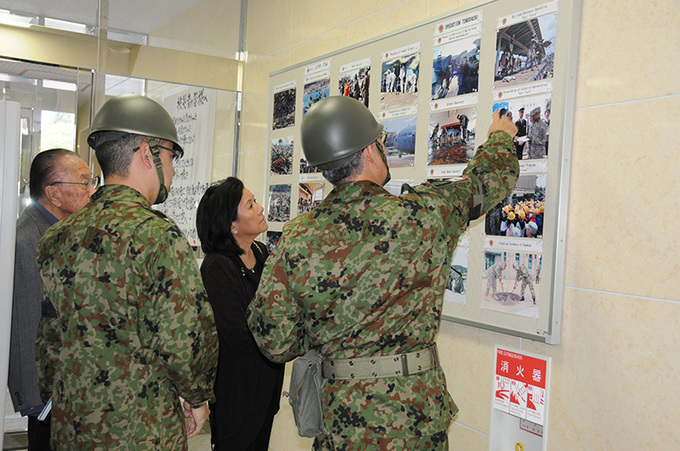
Visiting Tohoku in May, 2011, two months after the earthquake and tsunami, to receive an explanation of the "Operation TOMODACHI" disaster relief and support effort in which 24,000 U.S. military and 10,000 Japanese Self-Defense Force members participated.
TOMODACHI (Friendship) Initiative - Investing in the next generation of Japanese and Americans
The U.S.-Japan Council has launched the TOMODACHI Initiative to cultivate future leaders of Japan and the United States and to assist the long-term recovery of the quake-stricken areas through youth exchanges between the two countries. It is a unique public-private partnership, with the government of the United States, the U.S. Embassy in Japan, Ambassador John Roos, the U.S.-Japan Council, the Japanese government and major U.S. and Japanese corporations supporting the programs.
I am sure you have all heard of "Operation TOMODACHI," the U.S.-Japan joint disaster relief and recovery assistance effort after March 11. Over 24,000 U.S. military and 10,000 Japanese Self-Defense Force members participated in the operation. It was the spirit of friendship which was nurtured in the operation that gave rise to the TOMODACHI Initiative.
At the Annual Conference of the U.S.-Japan Council in 2011, U.S. Secretary of State Hillary Clinton remarked, "together, we want to create a TOMODACHI generation that is deeply committed to the future of our relationship." As we can see from her words, the initiative is very worthwhile in that it will nurture U.S.-Japan friendship and future leaders, and bring hope to Tohoku and other regions.
From 2012, the TOMODACHI Initiative has held over 20 programs in three fields with more than 800 participants. Around 450 young Japanese people, of whom 92 percent were students from the Tohoku region, went to the United States on exchange programs. In addition, some 1,000 young people participated in the events held in Tohoku. Many of the programs in the initial year targeted youth, and 70 percent of the participants were of high-school age or younger.
Now let me introduce some programs in the educational and academic field. For example in the "TOMODACHI Summer 2012 SoftBank Leadership Program," 300 students visited the University of California, Berkeley, where they studied cases of individuals who played a role in community development, and looked at ways of contributing to the revitalization of their own communities after returning to Japan. Another example is the "TOMODACHI Summer 2012 Coca-Cola Educational Homestay Program," in which 60 students stayed in homes in Lexington, Kentucky; Salem, Oregon; Erie, Pennsylvania; Burlington, Vermont, and various other locations. Some of the students were victims who had lost their families in the quake and tsunami. They expressed their thoughts saying that they had gained new families through the homestay. The third example is the "TOMODACHI MUFG International Exchange Program." In this program, the students stayed in homes in Southern California and studied Japanese American history.
The second field of the Initiative is culture: in other words, sports, music and the arts. Major League Baseball players visited the Tohoku region and held baseball classes. Players belonging to the National Basketball Association, the American Basketball Association and the U.S. Women's National Soccer Team also went to the Tohoku region and taught soccer and basketball directly to the students. Sports, music and the arts transcended language barriers to connect the young people of both nations.
The third field includes programs to foster leaders and entrepreneurs. Various competitions for business ideas took place with some NPO leaders participating. These programs are significant investments for the future and we intend to expand programs in this category in the years ahead. Secretary Clinton also supported the programs by meeting with the students this summer.
The number of Japanese students going to the U.S. to study has dropped by half over the past ten years. But we have found out through the TOMODACHI Initiative that young people in Japan still have a strong interest in the U.S., and many would like to study there. This means that if the funds, support, and opportunities are there, young people of the U.S. and Japan are willing and ready to study each other's culture.
Securing sustainability is the most important challenge
The most important issue for the future is sustaining the ties created among young people. Next spring, BEYOND Tomorrow is planning to hold leadership seminars for 100 participants of the programs held in the summer of 2012. In order to foster leaders, we need to make individual efforts by contacting young people through social media or by talking to them face-to-face. I would like to ask those of you who are reading this article to continue your support as our partners.
Receiving the Japan Foundation Award made me renew my appreciation of how important the relationship of trust between the U.S. and Japan is. The disaster of March 11, 2011 was an unfortunate event, but we were able to help relieve the hardships by providing funds donated by Americans. The donations were not given just out of sympathy. Many Americans felt the suffering as if it happened to them and gave money sincerely hoping for recovery. As Americans prayed for Japan's recovery, what came to the minds of many was the fact that the trust built between the two countries after World War II has really taken root. We may face many issues in the Asia-Pacific region in the future, but I truly hope that the two nations will together overcome such hurdles, deepen bilateral relations, and continue our friendship as allies.
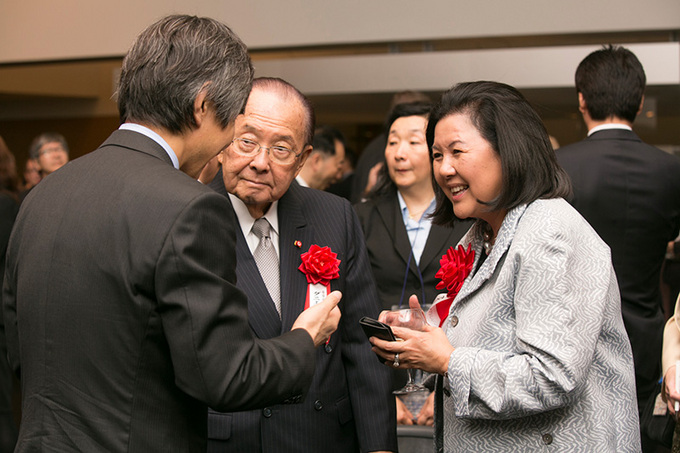
The writer and her husband Senator Daniel Inouye conversing with the audience after the commemorative lecture
Editors' note: It is with great sorrow that we have learned of the passing of Senator Daniel Inouye on December 17, 2012. We at the Japan Foundation would like to express our heartfelt condolences to the Inouye family and loved ones.
Lecture photos by Atsuko Takagi
Other photos provided by Irene Hirano Inouye
* Organizations/ positions of the people mentioned in the article are as of the time of writing (November 2012).
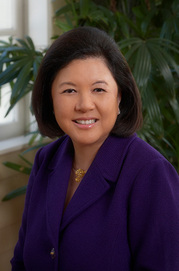 Irene Hirano Inouye
Irene Hirano Inouye
President, U.S.-Japan Council
Irene Hirano Inouye is the former President and the founding CEO of the Japanese American National Museum in Los Angeles, California, which aims to promote the history and experiences of Japanese Americans as part of the American heritage. After 20 years of service to the National Museum, she established the U.S.-Japan Council, a nonprofit organization that brings together leaders from both sides of the Pacific and organizes various exchange programs to strengthen U.S.-Japan relations. She was instrumental in launching the "TOMDACHI Initiative" with the United States and Japanese governments to deepen friendships and nurture the next generation of young people in the two nations for the ongoing support of Japan's recovery from the Great East Japan Earthquake. For many years she has acted as a bridge and contributed greatly to fostering ties between the people of the United States and Japan.
The Japan Foundation's involvement with Irene Hirano Inouye
The Japanese American National Museum (JANM) and the U.S.-Japan Council have both been long-time collaborators and recipients of grants from the Japan Foundation.
JANM, of which Irene Hirano Inouye is the founding CEO and former President, received the Japan Foundation Special Prize in 1999. The Japan Foundation has supported various projects by JANM to promote deeper understanding of Japanese-American history and culture in the United States.
She also has been committed to the "Japanese American Leadership Delegation (JALD) Program," which has been co-organized with the Ministry of Foreign Affairs of Japan and the Japan Foundation since fiscal 2000. She has an important role as a coordinator at public symposia co-organized by the U.S.-Japan Council and the Japan Foundation's Center for Global Partnership that are held each year as part of the JALD program, such as the symposium on "Empowering Civil Society for the Future of Japan," held in fiscal 2011.
Related Events
Keywords
- Music
- Sport
- Politics
- Social Securities/Social Welfare
- History
- NPO/NGO
- The Japan Foundation Awards
- Cultural Diversity
- Peacebuilding
- Japan
- United States
- U.S.-Japan Council
- Japanese American National Museum
- Los Angeles
- National Center for the Preservation of Democracy
- World War II
- Smithsonian
- Washington D.C.
- New York
- Ellis Island Immigration Museum
- Hawaii
- President Ronald Reagan
- Japanese Ministry of Foreign Affairs
- Japanese American Leadership Delegation Program
- Japan Platform
- Peace Boat
- "Genki Mail" project
- TOMODACHI Initiative
- Operation TOMODACHI
- U.S. Secretary of State Hillary Clinton
- University of California
- Berkeley
- Lexington
- Kentucky
- Salem
- Oregon
- Erie
- Pennsylvania
- Burlington
- Vermont
- National Basketball Association
- American Basketball Association
- U.S. Women's National Soccer Team
- BEYOND Tomorrow
- Great East Japan Earthquake
Back Issues
- 2019.8. 6 Unraveling the Maker…
- 2018.8.30 Japanese Photography…
- 2017.6.19 Speaking of Soseki 1…
- 2017.4.12 Singing the Twilight…
- 2016.11. 1 Poetry? In Postwar J…
- 2016.7.29 The New Generation o…
- 2016.4.14 Pondering "Revitaliz…
- 2016.1.25 The Style of East As…
- 2015.9.30 Anime as (Particular…
- 2015.9. 1 The Return of a Chin…


